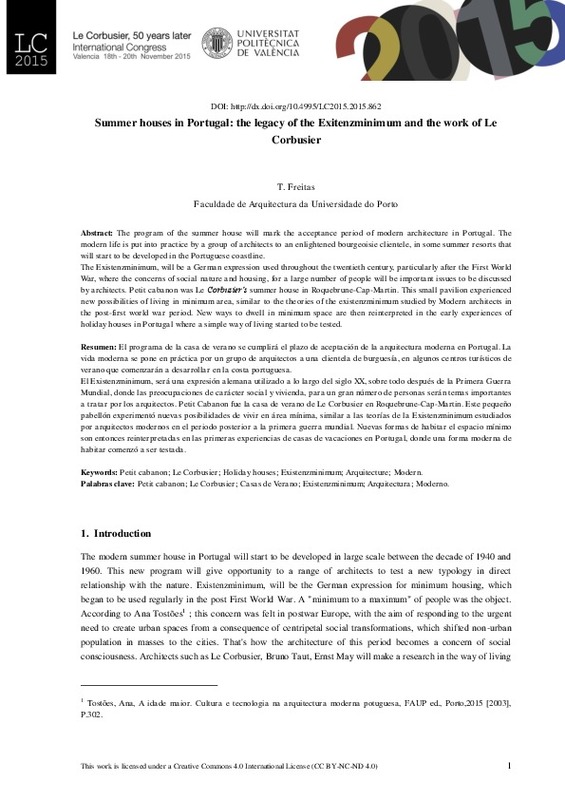JavaScript is disabled for your browser. Some features of this site may not work without it.
Buscar en RiuNet
Listar
Mi cuenta
Estadísticas
Ayuda RiuNet
Admin. UPV
Summer houses in Portugal: the legacy of the Exitenzminimum and the work of Le Corbusier
Mostrar el registro sencillo del ítem
Ficheros en el ítem
| dc.contributor.author | Freitas, Tiago
|
es_ES |
| dc.date.accessioned | 2017-09-13T06:24:59Z | |
| dc.date.available | 2017-09-13T06:24:59Z | |
| dc.date.issued | 2016-03-03 | |
| dc.identifier.isbn | 9788490483732 | |
| dc.identifier.uri | http://hdl.handle.net/10251/87133 | |
| dc.description.abstract | [EN] : The program of the summer house will mark the acceptance period of modern architecture in Portugal. The modern life is put into practice by a group of architects to an enlightened bourgeoisie clientele, in some summer resorts that will start to be developed in the Portuguese coastline. The Existenzminimum, will be a German expression used throughout the twentieth century, particularly after the First World War, where the concerns of social nature and housing, for a large number of people will be important issues to be discussed by architects. Petit cabanon was Le Corbusier’s summer house in Roquebrune-Cap-Martin. This small pavilion experienced new possibilities of living in minimum area, similar to the theories of the existenzminimum studied by Modern architects in the post-first world war period. New ways to dwell in minimum space are then reinterpreted in the early experiences of holiday houses in Portugal where a simple way of living started to be tested | es_ES |
| dc.description.abstract | [ES] El programa de la casa de verano se cumplirá el plazo de aceptación de la arquitectura moderna en Portugal. La vida moderna se pone en práctica por un grupo de arquitectos a una clientela de burguesía, en algunos centros turísticos de verano que comenzarán a desarrollar en la costa portuguesa. El Existenzminimum, será una expresión alemana utilizado a lo largo del siglo XX, sobre todo después de la Primera Guerra Mundial, donde las preocupaciones de carácter social y vivienda, para un gran número de personas serán temas importantes a tratar por los arquitectos. Petit Cabanon fue la casa de verano de Le Corbusier en Roquebrune-Cap-Martin. Este pequeño pabellón experimentó nuevas posibilidades de vivir en área mínima, similar a las teorías de la Existenzminimum estudiados por arquitectos modernos en el periodo posterior a la primera guerra mundial. Nuevas formas de habitar el espacio mínimo son entonces reinterpretadas en las primeras experiencias de casas de vacaciones en Portugal, donde una forma moderna de habitar comenzó a ser testada. | es_ES |
| dc.format.extent | 11 | es_ES |
| dc.language | Inglés | es_ES |
| dc.publisher | Editorial Universitat Politècnica de València | es_ES |
| dc.relation.ispartof | LE CORBUSIER. 50 AÑOS DESPUÉS | es_ES |
| dc.rights | Reconocimiento - No comercial - Sin obra derivada (by-nc-nd) | es_ES |
| dc.subject | architecture | es_ES |
| dc.subject | le corbusier | es_ES |
| dc.subject | modern movement | es_ES |
| dc.title | Summer houses in Portugal: the legacy of the Exitenzminimum and the work of Le Corbusier | es_ES |
| dc.type | Capítulo de libro | es_ES |
| dc.type | Comunicación en congreso | es_ES |
| dc.identifier.doi | 10.4995/LC2015.2015.862 | |
| dc.rights.accessRights | Abierto | es_ES |
| dc.description.bibliographicCitation | Freitas, T. (2016). Summer houses in Portugal: the legacy of the Exitenzminimum and the work of Le Corbusier. En LE CORBUSIER. 50 AÑOS DESPUÉS. Editorial Universitat Politècnica de València. 775-785. https://doi.org/10.4995/LC2015.2015.862 | es_ES |
| dc.description.accrualMethod | OCS | es_ES |
| dc.relation.conferencename | LC2015 - Le Corbusier, 50 years later | es_ES |
| dc.relation.conferencedate | November 18-20,2015 | es_ES |
| dc.relation.conferenceplace | Valencia, Spain | es_ES |
| dc.relation.publisherversion | http://ocs.editorial.upv.es/index.php/LC2015/LC2015/paper/view/862 | es_ES |
| dc.description.upvformatpinicio | 775 | es_ES |
| dc.description.upvformatpfin | 785 | es_ES |
| dc.type.version | info:eu-repo/semantics/publishedVersion | es_ES |
| dc.relation.pasarela | OCS\862 | es_ES |








